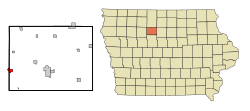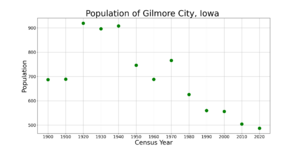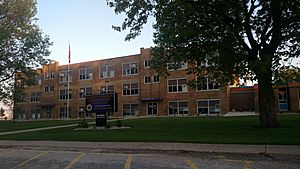Gilmore City, Iowa facts for kids
Quick facts for kids
Gilmore City, Iowa
|
|
|---|---|
| Motto(s):
"Iowa's Limestone Capital"
|
|

Location of Gilmore City, Iowa
|
|
| Country | |
| State | |
| Counties | Humboldt, Pocahontas |
| Area | |
| • Total | 1.24 sq mi (3.21 km2) |
| • Land | 1.24 sq mi (3.21 km2) |
| • Water | 0.00 sq mi (0.00 km2) |
| Elevation | 1,224 ft (373 m) |
| Population
(2020)
|
|
| • Total | 487 |
| • Density | 393.06/sq mi (151.76/km2) |
| Time zone | UTC-6 (Central (CST)) |
| • Summer (DST) | UTC-5 (CDT) |
| ZIP code |
50541
|
| Area code(s) | 515 |
| FIPS code | 19-30945 |
| GNIS feature ID | 0456906 |
| Website | Official website of Gilmore City, Iowa: http://www.gilmorecityiowa.com/ |
Gilmore City is a small city located in the state of Iowa, USA. It's special because it sits across two different counties: Humboldt and Pocahontas. In 2020, about 487 people lived there.
Contents
The Story of Gilmore City
How Gilmore City Started
Gilmore City began in 1884. This was soon after a railroad line was built through the area in 1882. The town was first called Blooming Prairie.
Naming the City
The name changed to Gilmore City in the early 1880s. It was named after Charles N. Gilmore. He was a superintendent for a railroad company. The community officially became a city on April 16, 1887.
Quarries and Fossils
North of Gilmore City, two large quarries were opened. These were the Midwest Limestone Quarry and the Hallett Quarry. They started producing quicklime and stone around 1882. Later, they also made cement.
In 1929, something exciting was found in these quarries: crinoid fossils! Crinoids are ancient sea animals that look a bit like plants. Today, the Midwest Limestone Quarry is known as the Moore Quarry.
Where is Gilmore City?
Gilmore City is located at 42°43′50″N 94°26′33″W / 42.73056°N 94.44250°W. The city covers about 3.21 square kilometers (1.24 square miles) of land.
Special Geology
Gilmore City is interesting because it sits on the edge of the Manson crater. This is a very old impact structure, like a giant bowl made by something hitting the Earth a long, long time ago. It's now buried under layers of dirt and rocks from glaciers.
How Many People Live Here?
| Historical populations | ||
|---|---|---|
| Year | Pop. | ±% |
| 1900 | 687 | — |
| 1910 | 689 | +0.3% |
| 1920 | 919 | +33.4% |
| 1930 | 896 | −2.5% |
| 1940 | 908 | +1.3% |
| 1950 | 746 | −17.8% |
| 1960 | 688 | −7.8% |
| 1970 | 766 | +11.3% |
| 1980 | 626 | −18.3% |
| 1990 | 560 | −10.5% |
| 2000 | 556 | −0.7% |
| 2010 | 504 | −9.4% |
| 2020 | 487 | −3.4% |
| Source: and Iowa Data Center Source: |
||
The population of Gilmore City has changed over the years. In 1920, it had its highest population with 919 people. By 2020, the population was 487.
A Look at the 2020 Census
In 2020, there were 487 people living in Gilmore City. Most residents were White. About 28.7% of the people were under 20 years old. The average age in the city was about 40.6 years.
Education in Gilmore City
Gilmore City is part of the Gilmore City–Bradgate Community School District.
The city has an elementary school for students from pre-kindergarten to sixth grade. After sixth grade, students attend middle school and high school in West Bend. This is because the Gilmore City–Bradgate district works together with the West Bend–Mallard Community School District.
See also
 In Spanish: Gilmore City (Iowa) para niños
In Spanish: Gilmore City (Iowa) para niños



